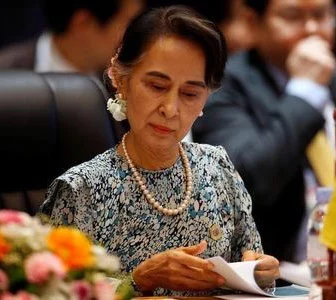Aung San Suu Kyi at the Asean Foreign Ministers’ Meeting in Vientiane, Laos, on July 24. Her comeback to Myanmar’s political arena signals a long-awaited democratic transition, but her performance in the first three months has been seen as disappointing.
IT was a normal Sunday in Vientiane, Laos, on’ July 24 but for the Asean Foreign Ministers’ Meeting, which witnessed the first and most talked about appearance of Aung San Suu Kyi. More famously known as “The Lady”, Suu Kyi emerged as Myanmar’s state counsellor cum foreign minister after the historic landslide victory of the National League of Democracy party, according the
people of Myanmar their first civilian government after more than 50 years under military rule.
A certain level of expectation sur-rounded The Lady, who has now passed her 100 days as state counsellor. To keen followers of Myanmar’s political events, her performance in her first three months has been rather slow and disappointing. The plight of the ethnic Rohingyas in particular, has been at the heart of the criticism. With patience running low among friends in Asean, Suu Kyi’s laid-back gestures have raised eyebrows among many. Some have compared her to Rodrigo Duterte, the newly elected president of the Philippines, an enthusiastic individual who appears to have walked his controversial talk within his 100 days in office, largely in cracking down on drugs and crime.
However, is Suu Kyi really that oblivious to the real concerns at hand? It is rather unfair to say so, given her de-termination to return the Panglong Agreement to life. As home to hundreds of ethnic groups, Myanmar has been the ground for grave, violent ethnic related conflicts since its independence in 1948. There is but little trust among the groups and, oftentimes, competition for influence and superiority has overwhelmed any political will to pursue peaceful reconciliation.
Years of political and economic isolation have also pushed a majority of the people to deprivation. This has, in turn, provoked resource-related conflicts, mainly in the northern region of the country. At the heart of the Panglong Agreement lies a hope for greater self-determination for minority groups. The agreement was crafted in 1947 to expel the lingering bad blood among majority and minority ethnic groups, when Myanmar had just entered its post-colonialisation period.
Suu Kyi inherited her father’s spirit in prioritising and wanting to address the deepest contributing factors to her country’s societal grievances. And yet, it is essential for her to understand that her leadership and credibility rest on her ability to strike a balance between achieving idea domestic policies and maintaining regional strategic common ground with neighbours, as part of the Asean community.
Malaysia, Thailand and Indonesia, in particular, had to grapple with the effects and implications of large flows of irregular migration after the boat people crisis last year. With almost 25,000 displaced persons flocking the borders of the three countries in the first quarter of last year,Suu Kyi could no longer afford to slow waltz her policies. Three major recommendations were laid out in the Putrajaya Joint Statement on Irregular Migration that was issued in May last year, in response to the crisis. The joint statement focused on comprehensive prevention, addressing root causes and improving the livelihoods of those in at-risk communities, reasonably consistent with what the new government of Myanmar wants to achieve with the Panglong Agreement.
If Suu Kyi is serious about affirming her commitments to improve the plight of the boat people, her government should certainly push for the nation’s active and inclusive participation in all the relevant discussions outlined and proposed by the joint statement. Asean, for its part and through the private sector, could help facilitate greater on-the-ground development initiatives within Myanmar to alleviate resource-related tensions in the country. Asean stakeholders could contribute a bigger injection in capital assistance under the Asean Integration plan, essentially in key sub-regional initiatives, such as the Asean-Mekong Basin Development Cooperation, Ayeyarwady-Chao Phraya-Mekong Economic Cooperation Strategy, and Bay of Bengal Initiative on Multi-Sector Technical and Economic Cooperation.
This can also be an opportune time for Myanmar and other Asean states to deepen people-to-people engagement, and continue earnest cooperation and the implementation of joint initiatives under the umbrella of the Asean Civil Society Conference/Asean Peoples’ Forum. Suu Kyi’s comeback to Myanmar’s political arena signals a long-awaited democratic transition that has long been advocated by the international community. And yet, as experts have observed, her endeavours, so far, have radiated only a sense of threat to the values of the aspired _ transition.
Ironing out the paradox is her next biggest and challenging step to maintain her relevance in the eyes of the international community. At the end of the day, The Lady will be expected to live up to her moniker, now that she has a chance to effect real change.
Article by Nurul Izzati Kamarulbahri which appeared in New Straits Times, August 9, 2016.





